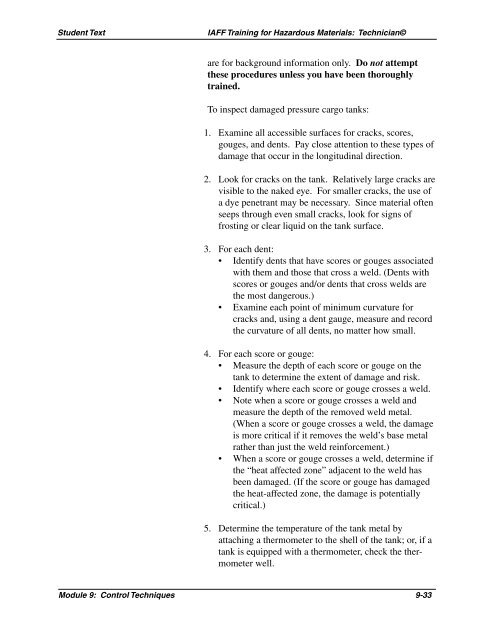Module 9: Control Techniques - International Association of Fire ...
Module 9: Control Techniques - International Association of Fire ...
Module 9: Control Techniques - International Association of Fire ...
Create successful ePaper yourself
Turn your PDF publications into a flip-book with our unique Google optimized e-Paper software.
Student Text IAFF Training for Hazardous Materials: Technician©<br />
are for background information only. Do not attempt<br />
these procedures unless you have been thoroughly<br />
trained.<br />
To inspect damaged pressure cargo tanks:<br />
1. Examine all accessible surfaces for cracks, scores,<br />
gouges, and dents. Pay close attention to these types <strong>of</strong><br />
damage that occur in the longitudinal direction.<br />
2. Look for cracks on the tank. Relatively large cracks are<br />
visible to the naked eye. For smaller cracks, the use <strong>of</strong><br />
a dye penetrant may be necessary. Since material <strong>of</strong>ten<br />
seeps through even small cracks, look for signs <strong>of</strong><br />
frosting or clear liquid on the tank surface.<br />
3. For each dent:<br />
• Identify dents that have scores or gouges associated<br />
with them and those that cross a weld. (Dents with<br />
scores or gouges and/or dents that cross welds are<br />
the most dangerous.)<br />
• Examine each point <strong>of</strong> minimum curvature for<br />
cracks and, using a dent gauge, measure and record<br />
the curvature <strong>of</strong> all dents, no matter how small.<br />
4. For each score or gouge:<br />
• Measure the depth <strong>of</strong> each score or gouge on the<br />
tank to determine the extent <strong>of</strong> damage and risk.<br />
• Identify where each score or gouge crosses a weld.<br />
• Note when a score or gouge crosses a weld and<br />
measure the depth <strong>of</strong> the removed weld metal.<br />
(When a score or gouge crosses a weld, the damage<br />
is more critical if it removes the weld’s base metal<br />
rather than just the weld reinforcement.)<br />
• When a score or gouge crosses a weld, determine if<br />
the “heat affected zone” adjacent to the weld has<br />
been damaged. (If the score or gouge has damaged<br />
the heat-affected zone, the damage is potentially<br />
critical.)<br />
5. Determine the temperature <strong>of</strong> the tank metal by<br />
attaching a thermometer to the shell <strong>of</strong> the tank; or, if a<br />
tank is equipped with a thermometer, check the thermometer<br />
well.<br />
<strong>Module</strong> 9: <strong>Control</strong> <strong>Techniques</strong> 9-33
















